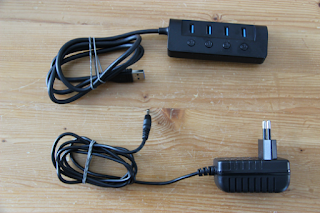At some point you might meet voltage issues on your Raspberry Pi.
Voltage issues if severe can cause disasters but most of time will only freeze your Pi every now and then.
This may be an issue for performance and stability and you might sometimes end frustrated while playing games.
There are two ways to power your Raspberry Pi with stability:
- Official Raspberry Pi power supply
- Powered USB hub
I didn't choose the former when I first bought my Pi because it lacked an on/off switch. It meant that every time I wanted to reboot my Raspberry Pi I would have to plug off and on which is not a very healthy way to manage one's electronic devices.
However, plugging your Raspberry Pi on a simple smartphone charger with a on/off switch USB wire will always cause voltage issue no matter if you choose a high amperage or not.
The Raspberry Pi in itself doesn't need much amperage. You will most of the time be fine with 1A. Still the Raspberry Pi needs a stable voltage and switches, cable length and cable material (which is often poor in case of pure USB cables) will make it drop and become unstable.
Another advantage of having a powered USB hub is that the USB hub manages the power of your external devices therefore relieves the power needs on your Raspberry Pi.
The U06_SML Atolla USB hub
 |
| Atolla USB hub U06_SML with AC/DC adapter |
- 15 cm / 6 in plain USB cable (no switch) between hub and Raspberry Pi
- Performance governor
- PS2 emulator running FFX CD
- The hub shows its limit when using the on/off switch port and doing heavy compilation. When doing heavy compilation it's recommended to plug your Raspberry Pi on the fast charge port and maybe remove the external hard drive.
- This is the only case when you have to look for your voltage. All the heavy games run fine.
- If you want to use the fast charging port on your Raspberry Pi, you will need a on/off switch USB cable which will be poor quality and will be likely to make you lose the advantage of voltage stability.
- The USB plugs are so tight that I broke 2 plastic cases in a row from my USB devices. If you plan never to remove your devices this isn't a problem but if you use an USB key to transfer files from your Raspberry Pi to your computer it can be a real annoyance.
 |
| One of the victims of Atolla USB hub's tight plugs |




No comments:
Post a Comment